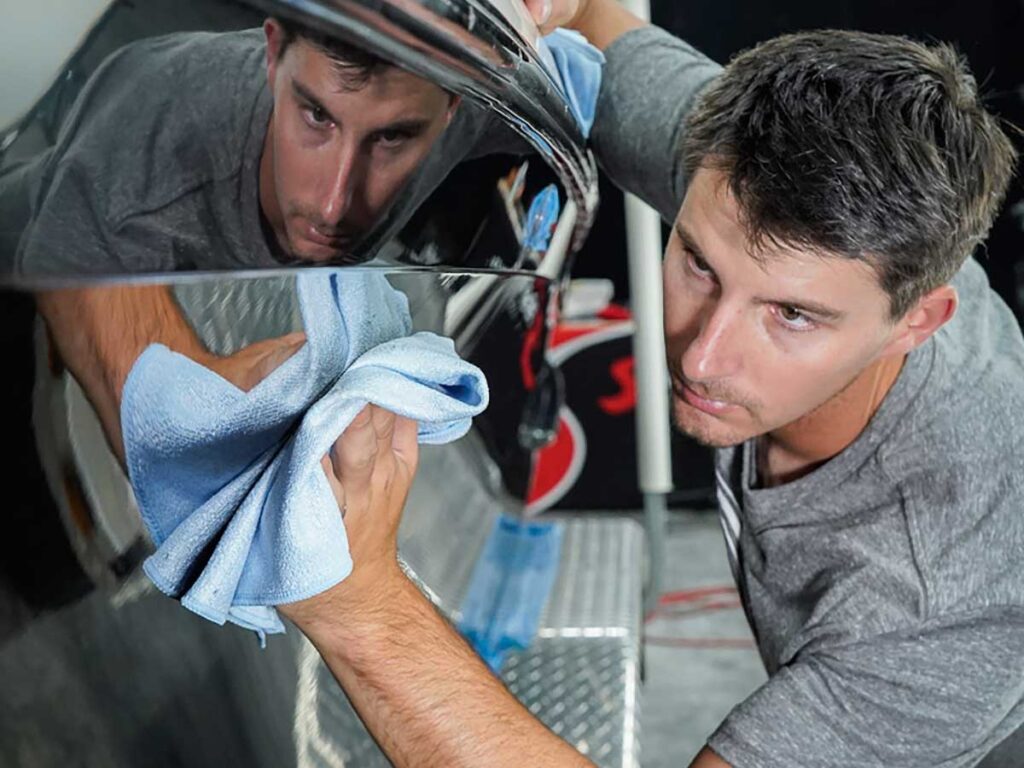
While a host of new-tech products such as ceramic coatings and graphene sprays has emerged to treat gelcoat finishes on fiberglass boats, traditional marine waxes remain among the most effective and least expensive ways to lay down a protective barrier from sunlight and stains. To learn how to achieve the best boat waxing results, we talked with Sam McGinley of Shurhold Industries, a boat-detailing expert who provided these eight tips.
Start With a Clean Surface
“Start with a finish that is as clean and smooth as possible,” McGinley says. A marine wax, be it paste or liquid, is not a corrective chemical; it is designed to seal, creating a shiny sacrificial barrier against UV and environmental fallout. But it will not make gelcoat look better, he explains. To improve the look, you will need to wash and dry the boat. Depending on the gelcoat condition, you also might need to apply rubbing compound to remove surface oxidation, eliminate stains, and/or degrease the surface. “This can represent as much as 90 percent of the work,” McGinley points out. “Only after you’re happy with the appearance of the finish should you begin the boat waxing process.”
Use a Pure Wax
There exists a multitude of products called waxes, including “cleaner waxes” that include compounding chemicals in addition to waxes. However, because McGinley recommends compounding and cleaning the surface beforehand, he prefers to use a pure wax such as Shurhold’s Pro Polish. Despite the name, it is a wax and sealant. Pure marine waxes from other brands include 3M Perfect-It Boat Wax, Meguiar’s M5616 Boat/RV Pure Wax, and Star brite Presoftened Boat Wax.
Avoid Direct Sunlight
Direct sunlight during the application intensifies surface temps, causing the wax to dry too quickly, reducing the working time. This causes the wax to cake up and become difficult to remove. Ideally, boat waxing should be done in a cool environment and in the shade.
Work in Small Areas
McGinley advises DIYers to work in small areas such as 2-by-2-foot or 3-by-3-foot sections, one at a time, whether applying by hand or with a buffing machine. Apply the wax within the square first in an up-and-down motion and then from side to side, to ensure full coverage. When applying by hand, use an applicator pad or a microfiber towel. With a buffer, use Shurhold’s Pro Polish pad, McGinley recommends.
Quick Cure Time
Allow only three to four minutes for each section to cure before buffing it out. Make sure you remove all of the hazy, cured boat wax using a clean microfiber towel (if buffing by hand) or a microfiber pad with a machine buffer.
Lots of Microfiber Towels
While terry towels used to be the traditional favorite, today, microfiber products are easier on gelcoat for both application and buffing. But you will want plenty of clean towels and machine pads standing by because the microfiber eventually becomes saturated with wax during application. It also loads up with wax residue when buffing. The good news is that you can wash microfiber products, but do so using cold water, not hot.
Read Next: Choosing the Right Buffer for Your Boat
Machine Boat Waxing
If you prefer to use a machine polisher versus hand-waxing, choose a dual-action oscillating buffer. “The random action of these labor-saving devices eliminates the risk of ‘burning’ edges of the boat’s gelcoat finish,” McGinley says, referring to a downside of incorrect use of single-action buffers.
Maintaining the Shine
“Wax is not something that lasts forever,” McGinley points out. “To maintain the shine and protective qualities, reapply three to four times each year.” Other steps include avoidance of harsh cleaning chemicals such as dishwashing soap or products containing chlorine—all of which strip away the wax’s protective barrier. “Use only a dedicated boat soap, and dry your boat with a microfiber towel each time after you wash it to eliminate the minerals deposited by water spots.”









